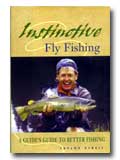Review: Instinctive Fly Fishing
EVER SINCE the idea of the “full-time professional fishing guide” came onstage, the number of books penned by guides has made up a smaller and smaller percentage of instructional writing. Perhaps the reason is simple: fishing professionals are out on the water because they are better at reading conditions than they are at writing about how to deal with them. But it might also be that as the numbers of fly fishers grows, the information accumulated from years of field experience isn’t lightly assembled, or easily tossed into the stream.
A lot of stuff that should get written about doesn’t. It also doesn’t help that there are a number books — especially in the past 15 years — authored by guides who spend their days dreaming about when they’ll get their hands on the fishing rod rather than thinking about how tomorrow’s conditions will warrant a change in strategy. These titles are generally mawkish or over-enthusiastic and usually have something to sell (the author), and we’re often left wondering whether the best instruction isn’t best found in the literature and not in the how-to section.
Taylor Streit (pronounced “Strite”) makes moves to change that with the release of Instinctive Fly Fishing: A Guide’s Guide to Better Fishing (204 pages, The Lyons Press, 2003). Mr. Streit, who is also the author of a “no-nonsense” guide to fly fishing New Mexico, where he is a long-time professional trout guide, wants to move anglers beyond the wives tales and popular presumptions of modern fly fishing to a more intuitive and natural approach.
The book is straight-up advice: Forget About That, but Try This. As the author notes in his introduction, he tried sitting at a computer screen and applying his knowledge to key strokes, but he wasn’t successful until he went back to the water with clients and with a tape recorder. The recording was spontaneous, and it allowed him to perceive the subtleties of various strategies of success.
In 29 quick chapters Mr. Streit drops a full sack of valuable knowledge in our laps, mostly relevant to stream fishing for trout (but quite a lot of which can be taken directly to salt water). Starting with suggestions for how to prepare the mind for catching fish —“Don’t scoff at the idea of bait fishing” — he asks readers to be willing to take the conditions at face value: “fish just don’t eat all the time.” In a word, he suggests anglers simplify.
The tips in the book are a mixture of the succinct —“Use Wide Gap Hooks,” “Walking Pays Off,” “Don’t Walk and Fish Simultaneously” — and the analytical — “Undoubtedly the two most costly mistakes nymph fishermen make are not recognizing a take and then not striking fast enough.” Surrounding this are suggestions for the types of stalking, casting, retrieving and water-reading techniques that will make a difference in the numbers of fish caught. For example, the author’s advice about not using too small a tippet — “I use 3X and 4X for most of my fishing” — won’t appear in most trout strategy books, but neither will the accounts of frail tippet causing lost fish. This is what’s good about the book: the author is selling nothing but his expertise.
The legendary Adirondacks guide Fran Betters showed the author how to catch reluctant trout on 1X and large dry flies at night and from a bridge by skating the flies over the water’s surface and striking on the sound. And a fisheries biologist once advised him, “Yes, 3-pound brown trout are in a beaver pond up there but you’ll have to walk a quarter mile and cross two fences to get to them.”
Other quick tales hold the narrative together, but the stories all point to a common theme, something along the lines of Get Real. The author gives us stuff only a guide would learn and understand and use to advantage. My favorites were his advice about fishing close to home, and about not telling others where the fish are: use “disguises, lies, whatever it takes. All’s fair in love, war — and the whisper of fishing spots.”
As A.K. Best notes in the jacket copy, Instinctive Fly Fishing doesn’t contain “a lot of high-tech double talk,” and it doesn’t pretend to be a bible of technical details. While there are a couple of copyediting errors and typos, the book is well-designed and effectively illustrated. Its 204 pages contain quite a catalog of ideas, and it does what it does extremely well: making most readers want to throw off the hair suit of science and bad advice and go catch fish.












